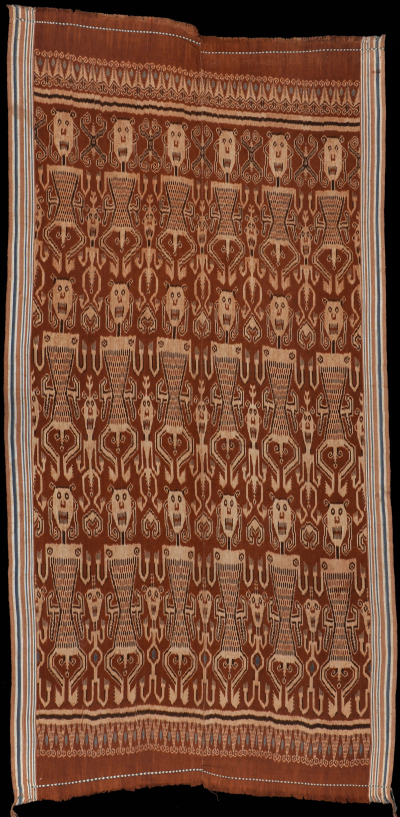| |
 
 | | | |
123 Borneo, Sarawak
Pua kumbu 
| | Locale: | Probably Batang Ai or Baleh river system. | | Period: | 1920-1940 | | Yarn: | Cotton, hand-spun, medium | | Technique: | Warp ikat | | Panels: | 2 | | Size: | 123 x 245 cm (4' 0" x 8' 0") LW: 1.99 | | Weight: | 1280 g (45.2 oz), 425 g/m2 (1.39 oz/ft2) | | Design: | Three rows of large male figures, antu, with exposed and accentuated genitals, interspersed with smaller human figures. Tumpal-like borders, different at top and bottom, representing birds in action. Natural dyes and spindle spun yarn, benang putar, exclusively. | | Comment: | Large and powerful old pua kumbu with striking human imagery. One panel is a little longer than the other, though the patterns are well aligned. The whole cloth is a little askew, but remarkably this hardly detracts from the strong overall visual impression. Because it is chocolate brown in tone it was probably dyed with enkerbai with chunam, lime, not the usual engkudu (morinda). | | Background: | Chapters on Borneo and Sarawak. | | Exhibited: | Museu do Oriente, Lisbon, 2014/15 | | Published: |
Woven Languages, 2014. | | Compare: | 075 | | Sources: | Similar to pua in Museum Nusantara, Delft, No. S3425-122. For the larger male figures see Chaddon c.s., Iban or Sea Dayak Fabrics, Plate IIc. For the smaller see Plate IIe. The tumpal-like tines most likely represent birds in action, see Chaddon, Plates VIIId,VIIIi, VIIIj and IXh. Note on origin by Vernon Kedit. | | |

©Peter ten Hoopen, 2025
All rights reserved.
|
|


